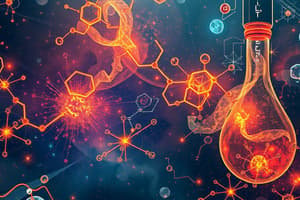Podcast
Questions and Answers
List the four observations that indicate that a chemical reaction may have taken place.
List the four observations that indicate that a chemical reaction may have taken place.
Chemical produced, energy change (light or heat), formation of precipitant, color change.
List the three requirements for a correctly written chemical equation.
List the three requirements for a correctly written chemical equation.
Represent known facts, have correct symbols and formulas, satisfy the law of conservation of mass.
What is meant by the term coefficient in a chemical equation?
What is meant by the term coefficient in a chemical equation?
How much the compound is being used in the reaction.
What is an aqueous solution?
What is an aqueous solution?
What is a catalyst?
What is a catalyst?
What is a reversible reaction?
What is a reversible reaction?
What are the four guidelines useful in balancing an equation?
What are the four guidelines useful in balancing an equation?
What does 'synthesis' refer to in chemistry?
What does 'synthesis' refer to in chemistry?
What does 'decomposition' refer to in chemistry?
What does 'decomposition' refer to in chemistry?
What does 'single replacement' refer to in chemistry?
What does 'single replacement' refer to in chemistry?
What does 'double replacement' refer to in chemistry?
What does 'double replacement' refer to in chemistry?
What does 'combustion' refer to in chemistry?
What does 'combustion' refer to in chemistry?
How are most decomposition reactions initiated?
How are most decomposition reactions initiated?
A substance is decomposed by an electric current, what is the name of this type of reaction?
A substance is decomposed by an electric current, what is the name of this type of reaction?
In what environment do many single replacement reactions commonly occur?
In what environment do many single replacement reactions commonly occur?
What is meant by the activity of an element?
What is meant by the activity of an element?
What is an activity series?
What is an activity series?
What is the basis in ordering of the elements on the activity series?
What is the basis in ordering of the elements on the activity series?
What chemical principle is the basis for the activity series of metals?
What chemical principle is the basis for the activity series of metals?
Flashcards are hidden until you start studying
Study Notes
Observations of Chemical Reactions
- Indicators of a chemical reaction include the production of a gas, energy changes (light or heat), formation of a precipitate, and color change.
Correctly Written Chemical Equations
- A correct chemical equation must represent known facts, utilize appropriate symbols and formulas, and adhere to the law of conservation of mass.
Coefficients in Chemical Equations
- Coefficients indicate the number of units of a compound participating in a chemical reaction.
Aqueous Solutions
- An aqueous solution is one where a substance is dissolved in water.
Catalysts
- Catalysts are substances that accelerate chemical reactions without being consumed in the process.
Reversible Reactions
- A reversible reaction allows the products to react and reform the original reactants.
Guidelines for Balancing Equations
- To balance a chemical equation, identify the names of reactants and products, write the formula equation, balance the equation, and verify the count of each type of atom.
Types of Reactions
- Synthesis: Combination of two reactants to form one product (A + B → AB).
- Decomposition: One reactant breaks down into two products (AB → A + B).
- Single Replacement: One element replaces another in a compound (AB + C → CB + A).
- Double Replacement: Exchange of elements between two compounds (AB + CD → CB + AD).
- Combustion: Reaction of a substance with oxygen, typically producing heat and light (A + O₂ → AO₂).
Initiation of Decomposition Reactions
- Decomposition reactions are often initiated by applying energy in the form of heat or electricity.
Electrolysis
- Decomposition by an electric current is referred to as electrolysis.
Environments for Single Replacement Reactions
- Many single replacement reactions occur in aqueous solutions, where the reactants are dissolved in water.
Activity of Elements
- An element's activity reflects its tendency to lose electrons easily, forming positive ions.
Activity Series
- The activity series ranks elements based on their reactivity, particularly in single replacement reactions.
Basis of the Activity Series
- The elements in the activity series are organized primarily based on their outcomes in single replacement reactions.
Principle Behind the Activity Series of Metals
- The reactivity of metals serves as the fundamental principle for ranking elements in the activity series.
Studying That Suits You
Use AI to generate personalized quizzes and flashcards to suit your learning preferences.



